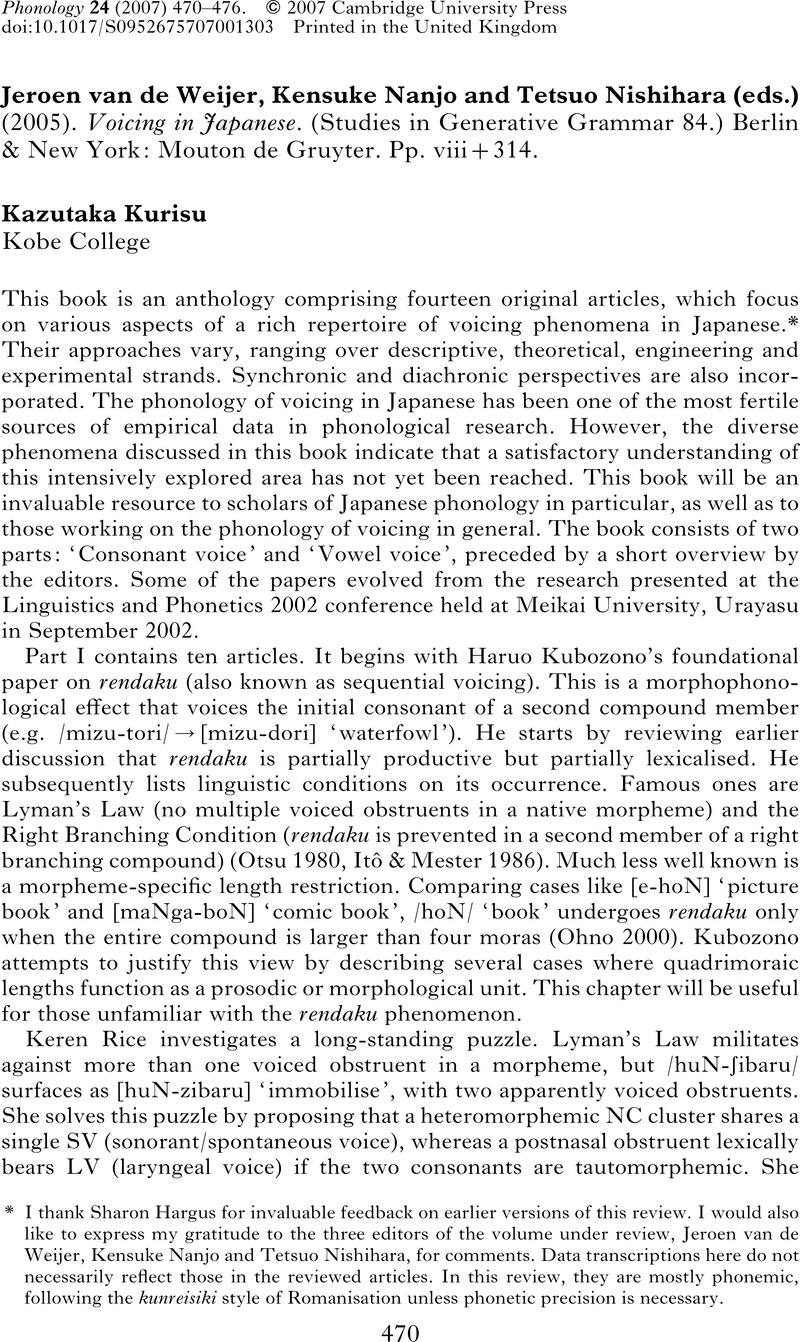No CrossRef data available.
Article contents
Jeroen van de Weijer, Kensuke Nanjo and Tetsuo Nishihara (eds.) (2005). Voicing in Japanese. (Studies in Generative Grammar 84.) Berlin & New York: Mouton de Gruyter. Pp. viii+314.
Review products
Jeroen van de Weijer, Kensuke Nanjo and Tetsuo Nishihara (eds.) (2005). Voicing in Japanese. (Studies in Generative Grammar 84.) Berlin & New York: Mouton de Gruyter. Pp. viii+314.
Published online by Cambridge University Press: 30 November 2007
Abstract
An abstract is not available for this content so a preview has been provided. Please use the Get access link above for information on how to access this content.

- Type
- Book Review
- Information
- Copyright
- Copyright © Cambridge University Press 2007
References
Fukazawa, Haruka & Kitahara, Mafuyu (2001). Domain relative faithfulness and the OCP: rendaku revisited. In Weijer, Jeroen van de & Nishihara, Tetsuo (eds.) Issues in Japanese phonology and morphology. Berlin & New York: Mouton de Gruyter. 85–109.CrossRefGoogle Scholar
Itô, Junko & Mester, Armin (1986). The phonology of voicing in Japanese: theoretical consequences for morphological accessibility. LI 17. 49–73.Google Scholar
Itô, Junko & Mester, Armin (1995a). Japanese phonology. In Goldsmith, John (ed.) The handbook of phonological theory. Cambridge, Mass. & Oxford: Blackwell. 817–838.Google Scholar
Itô, Junko & Mester, Armin (1995b). The core-periphery structure of the lexicon and constraints on reranking. In Beckman, Jill, Dickey, Laura Walsh & Urbanczyk, Suzanne (eds.) Papers in Optimality Theory. Amherst: GLSA. 181–209.Google Scholar
Itô, Junko & Mester, Armin (1999). The phonological lexicon. In Tsujimura, Natsuko (ed.) The handbook of Japanese linguistics. Malden, Mass. & Oxford: Blackwell. 62–100.Google Scholar
Ito, Junko & Mester, Armin (2003). Japanese morphophonemics: markedness and word structure. Cambridge, Mass.: MIT Press.CrossRefGoogle Scholar
Itô, Junko, Mester, Armin & Padgett, Jaye (1999). Lexical classes in Japanese: a reply to Rice. In Ussishkin, Adam, Herrick, Dylan, Kurisu, Kazutaka & Sanders, Nathan (eds.) Phonology at Santa Cruz 6. Santa Cruz: Linguistics Research Center. 39–46.Google Scholar
Kaye, Jonathan, Lowenstamm, Jean & Vergnaud, Jean-Roger (1990). Constituent structure and government in phonology. Phonology 7. 193–231.CrossRefGoogle Scholar
Kurisu, Kazutaka (2006). Theoretical implications of mimetic voicing in Japanese. In Vance, Timothy J. & Jones, Kimberly A. (eds.) Japanese/Korean Linguistics 14. Palo Alto: CSLI. 51–62.Google Scholar
Kurisu, Kazutaka (2007). Voicing asymmetry and relativized markedness. In Miyamoto, Yoichi & Ochi, Masao (eds.) MIT Working Papers in Linguistics 55. 161–172.Google Scholar
McCarthy, John J. (1999). Sympathy and phonological opacity. Phonology 16. 331–399.CrossRefGoogle Scholar
Ohno, Kazutoshi (2000). The lexical nature of rendaku in Japanese. In Nakayama, Mineharu & , Charles J., Quinn Jr. (eds.) Japanese/Korean linguistics 9. Stanford: CSLI. 151–164.Google Scholar
Otsu, Yukio (1980). Some aspects of rendaku in Japanese and related problems. In Otsu, Yukio & Farmer, Ann (eds.) Theoretical issues in Japanese linguistics. MIT Working Papers in Linguistics 2. 207–228.Google Scholar
Sugito, Miyoko (1965). Shibata-san to Imada-san: tango no tyookakuteki benbetu ni tuiteno iti koosatu [Mr Shibata and Mr Imada: a study on the auditory differentiation of words]. Gengo Seekatu 165. 64–72.Google Scholar


